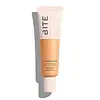What's inside
What's inside
 Key Ingredients
Key Ingredients

No key ingredients
 Benefits
Benefits

 Concerns
Concerns

 Ingredients Side-by-side
Ingredients Side-by-side

Water
Skin ConditioningC13-15 Alkane
SolventCoco-Caprylate/Caprate
EmollientPropanediol
SolventCetearyl Glucoside
EmulsifyingSorbitan Olivate
EmulsifyingCocos Nucifera Water
MaskingMica
Cosmetic ColorantSodium Hyaluronate
HumectantAloe Barbadensis Leaf Juice Powder
Skin ConditioningLeuconostoc/Radish Root Ferment Filtrate
AntimicrobialSynthetic Fluorphlogopite
Xanthan Gum
EmulsifyingCetearyl Alcohol
EmollientEthylhexylglycerin
Skin ConditioningPhenoxyethanol
PreservativeParfum
MaskingCI 77163
Cosmetic ColorantCI 77491
Cosmetic ColorantCI 77492
Cosmetic ColorantCI 77499
Cosmetic ColorantCI 77891
Cosmetic ColorantWater, C13-15 Alkane, Coco-Caprylate/Caprate, Propanediol, Cetearyl Glucoside, Sorbitan Olivate, Cocos Nucifera Water, Mica, Sodium Hyaluronate, Aloe Barbadensis Leaf Juice Powder, Leuconostoc/Radish Root Ferment Filtrate, Synthetic Fluorphlogopite, Xanthan Gum, Cetearyl Alcohol, Ethylhexylglycerin, Phenoxyethanol, Parfum, CI 77163, CI 77491, CI 77492, CI 77499, CI 77891
Water
Skin ConditioningC13-15 Alkane
SolventPropanediol
SolventIsododecane
EmollientPolyglyceryl-6 Polyricinoleate
EmulsifyingMica
Cosmetic ColorantPolymethylsilsesquioxane
Dimethicone
EmollientTrimethylsiloxysilicate
EmollientCaprylic/Capric Triglyceride
MaskingStearoxymethicone/Dimethicone Copolymer
EmollientCoco-Caprylate/Caprate
EmollientPolyglyceryl-10 Dioleate
EmulsifyingDisteardimonium Hectorite
StabilisingHydrogenated Lecithin
EmulsifyingSucrose Polystearate
EmollientSucrose Stearate
EmollientGlyceryl Caprylate
EmollientC24-28 Alkyl Methicone
EmollientPropylene Carbonate
SolventParfum
MaskingGlyceryl Undecylenate
EmollientXanthan Gum
EmulsifyingSodium Hydroxide
BufferingHelianthus Annuus Seed Oil
EmollientMaltose
MaskingAgave Tequilana Leaf Extract
AstringentTriethoxycaprylylsilane
Aristotelia Chilensis Fruit Extract
Skin ConditioningHexyl Cinnamal
PerfumingLinalool
PerfumingLimonene
PerfumingCI 77891
Cosmetic ColorantIron Oxides
Water, C13-15 Alkane, Propanediol, Isododecane, Polyglyceryl-6 Polyricinoleate, Mica, Polymethylsilsesquioxane, Dimethicone, Trimethylsiloxysilicate, Caprylic/Capric Triglyceride, Stearoxymethicone/Dimethicone Copolymer, Coco-Caprylate/Caprate, Polyglyceryl-10 Dioleate, Disteardimonium Hectorite, Hydrogenated Lecithin, Sucrose Polystearate, Sucrose Stearate, Glyceryl Caprylate, C24-28 Alkyl Methicone, Propylene Carbonate, Parfum, Glyceryl Undecylenate, Xanthan Gum, Sodium Hydroxide, Helianthus Annuus Seed Oil, Maltose, Agave Tequilana Leaf Extract, Triethoxycaprylylsilane, Aristotelia Chilensis Fruit Extract, Hexyl Cinnamal, Linalool, Limonene, CI 77891, Iron Oxides
Ingredients Explained
These ingredients are found in both products.
Ingredients higher up in an ingredient list are typically present in a larger amount.
C13-15 Alkane is a group of alkanes with 13 to 15 carbon atoms in the alkyl chain.
It is a solvent and texture enhancer. Solvents are used to keep ingredients together in a product. They can help dissolve ingredients to stable bases or help evenly distribute ingredients throughout the product.
Ci 77891 is a white pigment from Titanium dioxide. It is naturally found in minerals such as rutile and ilmenite.
It's main function is to add a white color to cosmetics. It can also be mixed with other colors to create different shades.
Ci 77891 is commonly found in sunscreens due to its ability to block UV rays.
Learn more about CI 77891Coco-Caprylate/Caprate is created from fatty coconut alcohol, caprylic acid, and capric acid.
It is a lightweight emollient. Emollients create a thin barrier on the skin to trap moisture in. This helps keep your skin hydrated and soft.
Once applied, Coco-Caprylate/Caprate is absorbed quickly and leaves a silky feel.
Coco-Caprylate/Caprate may not be fungal acne safe.
Learn more about Coco-Caprylate/CaprateMica is a naturally occurring mineral used to add shimmer and color in cosmetics. It can also help improve the texture of a product or give it an opaque, white/silver color.
Serecite is the name for very fine but ragged grains of mica.
This ingredient is often coated with metal oxides like titanium dioxide. Trace amounts of heavy metals may be found in mica, but these metals are not harmful in our personal products.
Mica has been used since prehistoric times throughout the world. Ancient Egyptian, Indian, Greek, Roman, Aztec, and Chinese civilizations have used mica.
Learn more about MicaParfum is a catch-all term for an ingredient or more that is used to give a scent to products.
Also called "fragrance", this ingredient can be a blend of hundreds of chemicals or plant oils. This means every product with "fragrance" or "parfum" in the ingredients list is a different mixture.
For instance, Habanolide is a proprietary trade name for a specific aroma chemical. When used as a fragrance ingredient in cosmetics, most aroma chemicals fall under the broad labeling category of “FRAGRANCE” or “PARFUM” according to EU and US regulations.
The term 'parfum' or 'fragrance' is not regulated in many countries. In many cases, it is up to the brand to define this term.
For instance, many brands choose to label themselves as "fragrance-free" because they are not using synthetic fragrances. However, their products may still contain ingredients such as essential oils that are considered a fragrance by INCI standards.
One example is Calendula flower extract. Calendula is an essential oil that still imparts a scent or 'fragrance'.
Depending on the blend, the ingredients in the mixture can cause allergies and sensitivities on the skin. Some ingredients that are known EU allergens include linalool and citronellol.
Parfum can also be used to mask or cover an unpleasant scent.
The bottom line is: not all fragrances/parfum/ingredients are created equally. If you are worried about fragrances, we recommend taking a closer look at an ingredient. And of course, we always recommend speaking with a professional.
Learn more about ParfumPropanediol is an all-star ingredient. It softens, hydrates, and smooths the skin.
It’s often used to:
Propanediol is not likely to cause sensitivity and considered safe to use. It is derived from corn or petroleum with a clear color and no scent.
Learn more about PropanediolWater. It's the most common cosmetic ingredient of all. You'll usually see it at the top of ingredient lists, meaning that it makes up the largest part of the product.
So why is it so popular? Water most often acts as a solvent - this means that it helps dissolve other ingredients into the formulation.
You'll also recognize water as that liquid we all need to stay alive. If you see this, drink a glass of water. Stay hydrated!
Learn more about WaterXanthan gum is used as a stabilizer and thickener within cosmetic products. It helps give products a sticky, thick feeling - preventing them from being too runny.
On the technical side of things, xanthan gum is a polysaccharide - a combination consisting of multiple sugar molecules bonded together.
Xanthan gum is a pretty common and great ingredient. It is a natural, non-toxic, non-irritating ingredient that is also commonly used in food products.
Learn more about Xanthan Gum